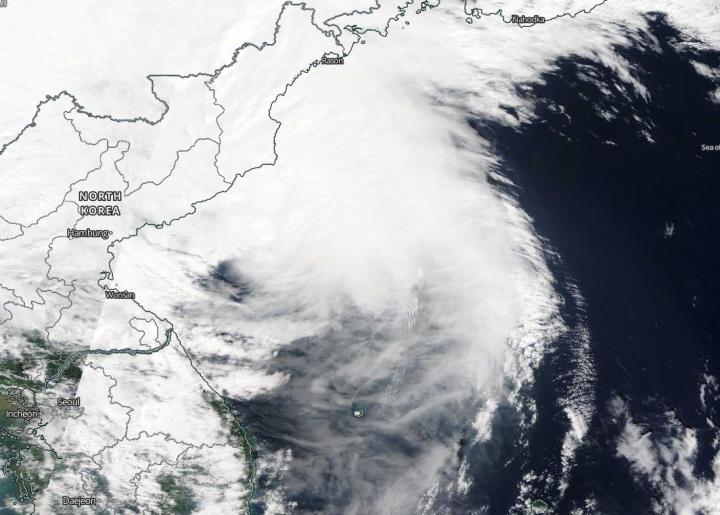
Credit: Credit: NASA Worldview, Earth Observing System Data and Information System (EOSDIS)
NASA-NOAA’s Suomi NPP satellite provided forecasters with a visible image of former Typhoon Maysak, now an extra-tropical storm. Wind shear continued pushing the bulk of the storm’s clouds to the northwest.
Maysak’s Landfall
Maysak made landfall on Sept. 2 at 1 p.m. EDT (1700 UTC) about 12 miles west of Busan, South Korea with maximum sustained surface winds of 64 knots (74 mph/119 kph).
Typhoon Maysak’s Final Status on Sept. 2
On Sept. 2 at 5 p.m. EDT (2100 UTC), the Joint Typhoon Warning Center (JTWC) issued their final bulletin on Maysak. At that time, Maysak was located near latitude 36.9 degrees north and longitude 128.9 degrees east. That is about 24 nautical miles north-northwest of Busan, South Korea. Maximum sustained surface winds were near 64 knots (74 mph/119 kph). Maysak was moving to the north-northeast. At the time, the JTWC noted, “Animated enhanced infrared satellite imagery and radar imagery indicate tightly-curved banding wrapping into a defined low-level circulation center.”
Maysak was undergoing extra-tropical transition late on Sept 2. It is embedded within the leading edge of a deep mid-latitude shortwave trough (elongated area of low pressure).
NASA’s Satellite View on Sept. 3
On Sept. 3, the Visible Infrared Imaging Radiometer Suite (VIIRS) instrument aboard Suomi NPP revealed southeasterly wind shear battering Maysak had exposed the center of circulation and pushed the bulk of clouds and precipitation to the northwest of the center. The storm extended from the Korean Peninsula into the Sea of Japan.
On Sept. 3, the system completed extra-tropical transition and gained frontal characteristics.
What is Wind Shear?
In general, wind shear is a measure of how the speed and direction of winds change with altitude. Tropical cyclones are like rotating cylinders of winds. Each level needs to be stacked on top each other vertically in order for the storm to maintain strength or intensify. Wind shear occurs when winds at different levels of the atmosphere push against the rotating cylinder of winds, weakening the rotation by pushing it apart at different levels.
What does Extra-tropical Mean?
When a storm becomes extra-tropical it means that a tropical cyclone has lost its “tropical” characteristics. The National Hurricane Center defines “extra-tropical” as a transition that implies both poleward displacement (meaning it moves toward the north or south pole) of the cyclone and the conversion of the cyclone’s primary energy source from the release of latent heat of condensation to baroclinic (the temperature contrast between warm and cold air masses) processes. It is important to note that cyclones can become extratropical and still retain winds of hurricane or tropical storm force.
This system is forecast to deepen as a storm-force extra-tropical low-pressure area over North Korea and China.
NASA Researches Tropical Cyclones
Hurricanes/tropical cyclones are the most powerful weather events on Earth. NASA’s expertise in space and scientific exploration contributes to essential services provided to the American people by other federal agencies, such as hurricane weather forecasting.
For more than five decades, NASA has used the vantage point of space to understand and explore our home planet, improve lives and safeguard our future. NASA brings together technology, science, and unique global Earth observations to provide societal benefits and strengthen our nation. Advancing knowledge of our home planet contributes directly to America’s leadership in space and scientific exploration.
###
By Rob Gutro
NASA’s Goddard Space Flight Center
Media Contact
Rob Gutro
[email protected]
Original Source
https:/




